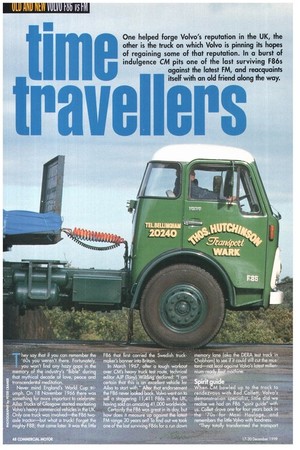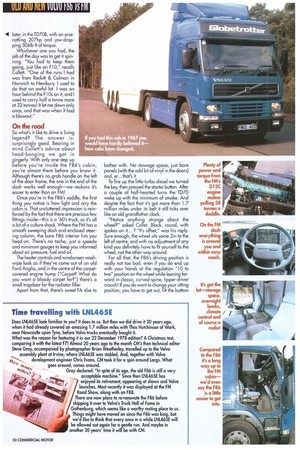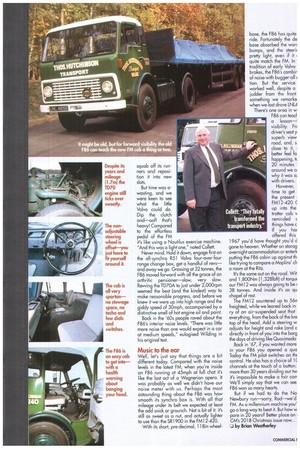One helped forge Volvo's reputation in the UK, the other
Page 50

Page 51

Page 52

Page 53

If you've noticed an error in this article please click here to report it so we can fix it.
is the truck on which Volvo is pinning its hopes of regaining some of that reputation. In a burst of indulgence CM pits one of the last surviving F86s against the latest FM, and reacquaints • itself with an old friend along the way.
hey say that if you can remember the '60s you weren't there. Fortunately, you won't find any hazy gaps in the memory of the industry's "Bible" during that mythical decade of love, peace and transcendental meditation.
Never mind England's World Cup trip. urnph. On 18 November 1966 there was
something far more important to celebrate: Ailsa Trucks of Glasgow started marketing
Volvo's heavy commercial vehicles in the UK. r3 Only one truck was involved—the F86 two5 axle tractor—but what a truck! Forget the if. mighty F88; that came later. It was the little
F86 that first carried the Swedish truckmaker's banner into Britain.
In March 1967, after a tough workout over CM'S heavy truck test route, technical editor AJP (Tony) Wilding declared: "I am certain that this is an excellent vehicle for Ailsa to start with." After that endorsement the F86 never looked back. Volvo went on to sell a staggering 11,411 F86s in the UK, having sold an amazing 41,000 worldwide. Certainty the F86 was great in its day, but how does it measure up against the latest FM range 30 years on? To find out we took one of the last surviving F86s for a run down memory lane {aka the DERA test track in Chobham) to see if it could still cut the mustard—not least against Volvo's latest millen nium-ready t machine.
Spirit guide
When CM bowled up to the track to rendezvous with Rod Collett, Volvo's demonstration specialist, little did we realise we had an F86 "spirit guide" with us. Collett drove one for four years back in the '70s for Maxi Haulage, and remembers the little Volvo with fondness.
"They totally transformed the transport industry," he recalls. "1 used to work on old Leylancls and Fords, and compared to Guy Big is and Scammell Crusaders they were so easy to drive."
There were few, if any, true sleeper cabs in those days, and the F86 was no exception. The answer? A touch of DIY bodybuilding, as Collett explains: "You made up a bunk base yourself and took the passenger seat backrest off. Then you got someone to make you up an angle iron support for the base and get it to the height of the board, and you could put the bed on top of that."
The arrangement certainly deterred hitch
hikers, if nothing else! "'With all that glass next to you it was cold in the winter," recalls Collett. "A night heater? I used two sleeping bags!" As we climb into the cab, CoIleit offers us a word of warning. 'Watch out getting in! F86 drivers were always bashing their heads on the low roof."
Even though conditions were pretty cramped by today's standards—there's no storage space, and the finish is pretty spartan right down to the peg-board roof lining—Collett has nothing but good memories of Volvo's little fleetmeister. "It's difficult to
realise now that this was the if you think of what a Guy Big 1 was like, itwas like a breath of you had to put a box of food and your bag in the passenger at least you got some comfort." At a time when most UK were fitting large, naturally as in their heavy wagons ("Yes, have a Gardner, Gardner or F86 broke new ground by vi 6.7-litre turbocharged six-pa 185hp and with 456Ib ft 1,400rpm From the 1070A
later, in the TD70B, with an arserattling 207hp and jaw-dropping 506Ib ft of torque.
Whichever one you had, the job of the day was to get it spinning. "You had to keep them going, just like an Fl 0," recalls Collett. "One of the runs I had was from Reckitt & Colman in Norwich to Newbury. I used to do that an awful lot. I was an hour behind the F] Os on it, and I used to carry half a tonne more at 32 tonnes! It let me down only once, and that was when it had a blowout."
On the road
So what's it like to drive a living legend? The answer is: surprisingly good. Bearing in mind Collett's advice about head-banging we got in gingerly. With only one step up before you're inside the F86's cabin, you're almost there before you know it. Although there's no grab handle on the left of the door frame, the one in the end of the dash works well enough—we reckons it's easier to enter than an FM!
Once you're in the F86's saddle, the first thing you notice is how light and airy the cabin is. That uncluttered impression is reinforced by the fact that there are precious few fittings inside—this is a '60's truck, so it's all a bit of a culture shock. Where the FM has a smooth sweeping dash and enclosed steering column, the bare F86 interior hits you head-on. There's no tacho, just a speedo and minimum gauges to keep you informed about air pressure, fuel and oil.
The heater controls and windscreen washwipe look as if they've come out of an old Ford Anglia, and in the centre of the carpetcovered engine hump ("Carpet? What do you want a bloody carpet for?") there's a small trapdoor for the radiator filler. Apart from that there's sweet FA else to
bother with. No stowage space, just bare panels (with the odd bit of vinyl in the doors) and, er... that's it.
To fire up the little turbo diesel we turned the key, then pressed the starter button. After a couple of half-hearted turns the 1D70 woke up with the minimum of smoke. And despite the fact that it's got more than 1 .7 million miles under its belt it still ticks over like an old grandfather clock.
"Notice anything strange about the wheel?" asked Collet. Black, round, with spokes on it... ? "It's offset," was his reply. Sure enough, the wheel sits some 2in to the left of centre, and with no adjustment of any kind you definitely have to fit yourself to the wheel, not the other way around. For all that, the F86's driving position is really not too bad, even if you do end up with your hands at the regulation "10 to two" position on the wheel while leaning forward in classic, curved-spine, tipper-driver crouch! If you do want to change your sitting position, you have to get out, lift the bottom squab off its runners and reposition it into new slots.
But time was awasting, and we were keen to see what the little Volvo could do. Dip the clutch and—oof! that's heavyl Compared to the effortless pedal of the FM it's like using a Nautilus exercise machine. "And this was a light one," noted Collett. Never mind. Hold it down, engage first on the all-synchro R51 Volvo four-over-four range change box, get a handful of revs— and away we go. Grossing at 32 tonnes, the F86 moved forward with all the grace of an arthritic pensioner—slow, very slow. Revving the TD70A to just under 2,000rpm seemed the best (and the kindest) way to make reasonable progress, and before we knew it we were up into high range and the giddy speed of 30mph, accompanied by a distinctive smell of hot engine oil and paint. Back in the '60s people raved about the F86's interior noise levels_ "There was little more noise than one would expect in a car at medium speeds," eulogised Wilding in his original test.
Music to the ear Well, let's just say that things are a bit different today. Compared with the noise levels in the latest FM, when you're inside an F86 running at 45mph at full chat it's like the last act of a Wagnerian opera. It was probably as well we didn't have our noise meter with us. Perhaps the most astounding thing about the F86 was how smooth its synchro box is. With all that mileage under its belt we expected at least the odd snick or graunch. Not a bit of it it's still as sweet as a nut, and actually lighter to use than the SR1900 in the FM12-420.
With its short, pre-decimal, 118in wheel
base, the F86 has quite ride. Fortunately the de base absorbed the w0r5 bumps, and the steerii pretty light, even if it quite match the FM, In tradition of early Volvo brakes, the F86's combir of noise with bugger-all tion. But the service worked well, despite a judder from the front
something we remarke when we last drove LN1.4 There's one area in w F86 can teacl
a lesson—I visibility. Fr< driver's seat), superb view road, and, s close to it, , better feel fo happening, k 20 minutes around we a why it was st.
with drivers. However, time to get
the present FM] 2-420. ( up Into the trotter cab v reminded c things have c If you hoc offered this 1967 you'd have thought you'd d gone to heaven. Whether on storag overnight accommodation or entert■ putting the F86 cabin up against th, like trying to compare a Maplins' ch o room at the Ritz.
It's the same out on the road. Wit' and 1,800Nm (1,3281bft) of torquE our FM12 was always going to be 38 tonnes. And inside it's as qu chapel of rest. The FM12 sauntered up to 56n freighted, while we leaned back in ry of an air-suspended seat that everything, from the back of the knc top of the head. Add a steering w adjusts for height and rake (and c directly in front of you into the barg the days of driving like Quasimodo Back in '67, if you wanted more in your F86 you opened a qua Today the FM pilot switches on thc control. He also has a choice of 1C channels at the touch of a button. more than 30 years dividing our tw it's impossible to make a fair corr We'll simply say that we can see F86 won so many hearts. But if we had to do the No Newbury run—sorry, Rod—we'd FM. As a millennium machine you' go a long way to beat it. But how w pare in 20 years? Better place an CM's 2018 Christmas issue now...
by Brian Weatherley
Collett: "They totally transformed the transport industry."
Time travelling with LNL465E
Does LNL465E look familiar to you? It does to us. But then we did drive it 20 years ago, when it had already covered an amazing 1.7 million miles with Thos Hutchinson of Work, near Newcastle upon Tyne, before Volvo frucks eventually bought it. What was the reason for featuring it in our 22 December 1978 edition? A Christmas test, comparing it with the latest F7! Almost 20 years ago to the month CM'S then technical editor
Steve Gray, accompanied by photographer Brian Weatherley, travelled up to the Volvo assembly plant at Irvine, where 1N1465E was stabled, And, together with Volvo development engineer Chris Evans, CM took it for a spin around Largs. What goes around, comes around.
Gray declared: "In spite of its age, the old F86 is still a very
acceptable machine." Since then LNL465E has enjoyed its retirement, appearing at shows and Volvo launches. Most recently it was displayed at the FM Road Show, along with an F88.
There are now plans to re-renovate the F86 before shipping it over to Volvo's Truck Hall of Fame in Gothenburg, which seems like a worthy resting place to us. Things might have moved on since the F86 was king, but we'd like to think that every once in a while INL465E will be allowed out again for a gentle run. And maybe in another 20 years' time it will be with CM.












































































































































